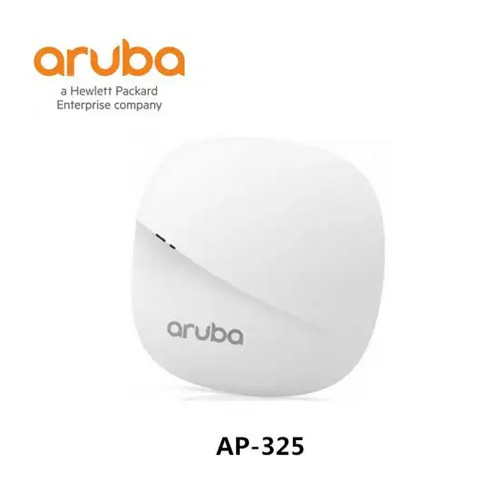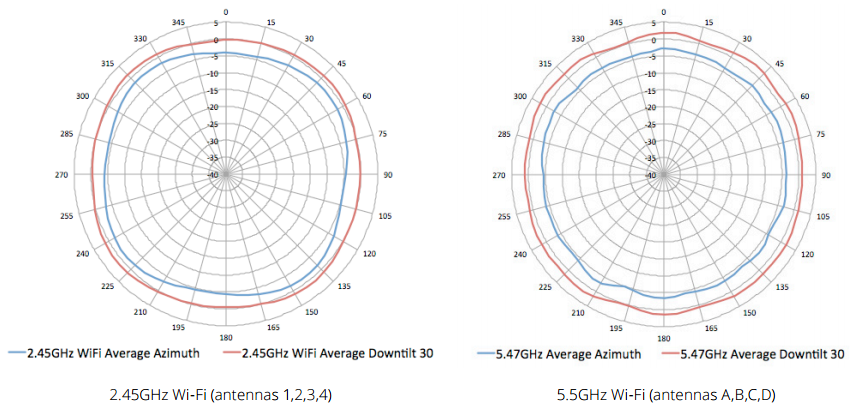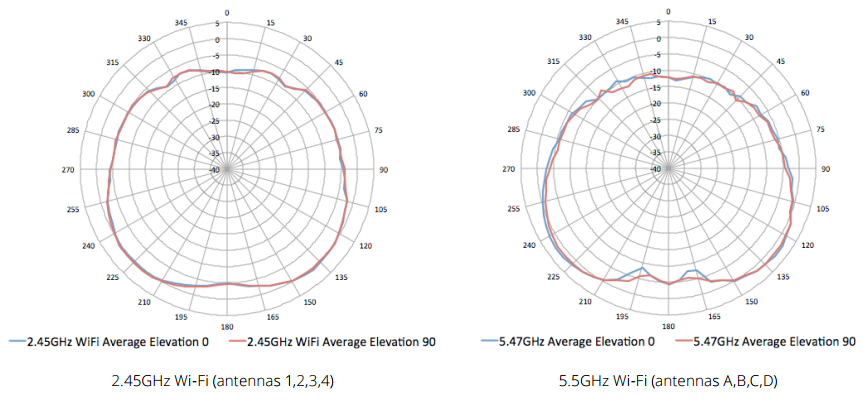
Aruba Access Point 325
Thewireless AP Aruba Access Point 325 multi-functionalprovides the best possible Wi-Fi 802.11ac connectivity and user experience. Featuring enhanced ClientMatch and Aruba Beacon technologies from Aruba, the 320 series enables ultimate performance, performance, and performance in extremely high density environments.
Request a Quote
DESCRIPTION
Thewireless AP Aruba Access Point 325 multi-functionalprovides the best possible Wi-Fi 802.11ac connectivity and user experience. Featuring enhanced ClientMatch and Aruba Beacon technologies from Aruba, the 320 series enables the highest capacity, performance and efficiency in extremely high density environments.
With a maximum concurrent data rate of 1,733 Mbps in the 5 GHz band and 800 Mbps in the 2.4 GHz band (2.5 Gbps compound date rate), the 320 Series Access Points provide the best-in-class next-generation 802.11ac Wi-Fi infrastructure for the highest density environments.
The high-performance, high-density 802.11ac 320 series supports multi-user MIMO (MU-MIMO) and 4 streams of spatial Access Points (4SS). It provides simultaneous data transmission to multiple devices, maximizes data throughput and improves network efficiency.
The 320 Series includes enhanced patent pending ClientMatch technology that expands client steering technology with MU-MIMO client awareness. Automatically identifies MU-MIMO-enabled mobile devices and directs them to the nearest MU-MIMO-enabled Aruba access point. By grouping mobile devices that support MU-MIMO, the network is starting to take advantage of simultaneous transmissions to these devices, increasing their overall capacity. Dynamic roaming policies, based on this device type, help customers achieve the best WLAN performance in mixed device environments during technology transitions.
The 320 Series has an integrated Bluetooth Aruba Beacon which simplifies remote management of the large-scale Aruba battery-powered beacon network while providing advanced location and indoor streetfinding, as well as proximity-based push notification capabilities. This enables businesses to take advantage of the mobility context to develop applications that will provide an enhanced user experience and increase the value of wireless networks for organizations.
Increase network efficiency
With multi-user MIMO (MU-MIMO), you can send to multiple Wave 2 clients from the AP, at the same time.
ClientMatch launches MU-MIMO
Aruba ClientMatch software batches Wave 2 clients, enabling MU-MIMO. That means a faster and more efficient network.
Integrated Bluetooth Beacon The
320 series AP has an integrated BLE Beacon to simplify large-scale network management of battery-powered Aruba Beacons.
Choose your mode of operation
The Aruba 320 Series Access Points offer a choice of operating modes to meet your unique management and deployment needs.
- Controller-managed mode – When managed by the Aruba Mobility Controller, the Aruba 320 Series Access Points offer centralized configuration, data encryption, policy enforcement, and network services, as well as centralized, distributed traffic forwarding.
- Aruba Instant mode – In Aruba Instant mode, one AP automatically distributes network configuration to other Instant APs on the WLAN. Just power on one Instant AP, configure over the air, and plug in another AP – the whole process takes about five minutes. If the WLAN requirements change, the internal migration path allows the 320 series Instant AP to become part of the WLAN managed by the Mobility Controller.
- Remote AP (RAP) for branch deployment
- Air monitor (AM) for wireless IDS, rogue detection and containment
- Spectrum analyzers, dedicated or hybrid, to identify sources of RF interference
- Secure corporate nets
For large installations at multiple sites, the Aruba Activate service significantly reduces deployment time by automating device provisioning, firmware upgrades, and inventory management. With Aruba Activate, Instant APs are sent from the factory to any site and configured themselves at startup.
Benefits:
4×4 802.11ac dual radio access point with multi-user MIMO
- Supports up to 1.733 Mbps in the 5 GHz band (with 4SS / VHT80 clients) and 800 Mbps in the 2.4 GHz band (with 4SS / VHT40 clients).
Built-in Low Energy (BLE) Bluetooth Radio
- Enables location-based services with a BLE-capable mobile device that receives signals from multiple Aruba Beacons simultaneously.
- Simplifies battery-powered Aruba beacon management.
Advanced Cellular Coexistence (ACC)
- Minimizes interference from 3G / 4G cellular networks, distributed antenna systems, and commercial small cell / femtocell equipment.
Quality of service for Unified Communications applications
- Support priority handling and policy enforcement for unified communications applications, including Microsoft Skype for Business with encrypted video conferencing, voice, chat, and desktop sharing.
RF Management
- Adaptive Radio Management (ARM) technology automatically assigns channel and power settings, provides fair broadcast time, and ensures that the AP is kept clear of all sources of RF interference for a reliable, high-performance WLAN.
- The Aruba 320 Series Access Points can be configured to provide part-time or dedicated air monitoring for spectrum analysis and wireless intrusion protection, VPN tunnels for extending remote locations to corporate resources, and wireless mesh connections where Ethernet droplets are not available.
Spectrum Analysis
- Capable of part-time or dedicated air monitoring, the spectrum analyzer remotely scans the 2.4 GHz and 5 GHz radio bands to identify sources of RF interference.
Smart Application Visibility and Control
- AppRF technology takes advantage of deep packet inspection to classify and block, prioritize, or limit bandwidth for more than 1,500 enterprise applications or application groups.
Security
- Integrated wireless intrusion protection offers protection and threat mitigation, and eliminates the need for separate RF sensors and security equipment.
- IP reputation and security services identify, classify, and block malicious files, URLs and IPs, providing comprehensive protection against advanced online threats.
- Integrated Trusted Platform Module (TPM) for secure storage of credentials and keys. – SecureJack-able to secure tunneling of wired Ethernet traffic.
AP-320 Series Specifications
- AP-325 and IAP-325
- 5 GHz (1.733 Mbps max rate) and 2.4 GHz (800 Mbps max rate) radios, each with 4×4 MIMO support and a total of eight integrated omni-directional downtilt antennas.
- AP-324 and IAP-324
- 5 GHz (1.733 Mbps max rate) and 2.4 GHz (800 Mbps max rate) radios, each with 4×4 MIMO support and a total of four combined, diplexed (dual-band) external RP-SMA antenna connectors .
Wireless Radio Specifications
- AP type: Indoor, dual radio, 5 GHz 802.11ac and 2.4 GHz 802.11n 4×4 MIMO.
- Software-configurable dual radio supports 5 GHz (Radio 0) and 2.4 GHz (Radio 1).
- Four SU-MIMO spatial streams of up to 1,733 Mbps wireless data rates to a single client device.
- Three MU-MIMO spatial streams for wireless data rates of up to 1,300 Mbps for up to three MU-MIMO-enabled client devices simultaneously.
- Support for up to 255 associated client devices per radio, and up to 16 BSSIDs per radio.
- Supported frequency bands (country specific restrictions apply):
- 2,400 to 2.4835 GHz
- 5,150 to 5,250 GHz
- 5,250 to 5,350 GHz
- 5,470 to 5,725 GHz
- 5,725 to 5,850 GHz
- Available channels: Depends on the configured regulatory domain.
- Dynamic frequency selection (DFS) optimizes the use of the available RF spectrum.
- Radio technology supported:
- 802.11b: Direct-sequence spread-spectrum (DSSS)
- 802.11a / g / n / ac: Orthogonal frequency-division multiplexing (OFDM)
- Supported modulation types:
- 802.11b: BPSK, QPSK, CCK
- 802.11a / g / n / ac: BPSK, QPSK, 16-QAM, 64-QAM, 256-QAM
- Transmitting power
: Configurable in increments of 0.5 dBm - Maximum transmit power (aggregated, total conducted) (limited by local regulatory requirements):
- 2.4 GHz band : +24 dBm (18 dBm per chain)
- 5 GHz band: +24 dBm (18 dBm per chain)
- Note: the transmit power level performed does not include antenna gain. For total transmit power (EIRP), addingantenna gain
- Advanced Cellular Coexistence (ACC)minimizes interference from the cellular network.
- Maximum combining ratio (MRC) to improve receiver performance.
- Cyclic delay / shift diversity (CDD / CSD) to improve RF downlink performance.
- Short keeper intervals for 20-MHz, 40-MHz and 80-MHz channels.
- Space-time block coding (STBC) for wider reach and better reception.
- Low-density parity check (LDPC) for high efficiency error correction and increased throughput.
- Transmit beamforming (TxBF) for increased reliability and signal coverage.
- Supported data rates (Mbps):
- 802.11b: 1, 2, 5.5, 11
- 802.11a / g: 6, 9, 12, 18, 24, 36, 48, 54
- 802.11n: 6.5 to 450 (MCS0 to MCS23)
- 802.11 ac: 6.5 to 1,733 (MCS0 to MCS9, NSS = 1 to 4)
- 802.11n high-throughput (HT) support: HT 20/40
- 802.11ac very high throughput (VHT) support: VHT 20/40/80
- 802.11n / ac packet aggregation: A-MPDU, A-MSDU
WiFi Antenna
- AP-324 / IAP-324:
- Four RP-SMA connectors for external dual band antenna. Internal loss between radio interface and external antenna connector (due to diplexed circuit): 2.5 dB at 2.4 GHz and 1.5 dB at 5 GHz.
- AP-325 / IAP-325:
- Eight integrated downtilt omni-directional antennas for 4×4 MIMO with maximum antenna gain of 3.5 dBi in 2.4 GHz and 5.0 dBi in 5 GHz. The internal antenna is optimized for the orientation of the horizontal ceiling mounted AP. Tilt angle for maximum gain of ~ 30 degrees.
Other Interfaces
- Two 10/100 / 1000BASE-T Ethernet network interfaces (RJ-45)
- Automatic sensor link speed and MDI / MDX
- Load balancing support to achieve platform throughput of over 1 Gbps
- Energy Saving Ethernet (EEE) 802.3az
- PoE-PD: 48 Vdc (nominal) 802.3af or 802.3at PoE
- DC power interface, accepts 2.1 / 5.5 mm center positive circular connector with a length of 9.5 mm
- USB 2.0 host interface (Type A connector)
- Bluetooth Radio Energy Efficient (BLE)
- Power transmit up to 4dBm (class 2) and -94dBm receive sensitivity
- Antenna integrated, gain -5dBi (30 degree tilt)
- Can be disabled by configuration
- Visual indicators (tri-color LED): For system and radio status
- Reset Button: Factory reset (while powering up device)
- Serial console interface (RJ-45)
- Kensington security slot
Power Source and Consumption
- Maximum (worst-case) power consumption: 20W (802.3at PoE), 13.5W (802.3af PoE) or 18.5W (DC) Excludes the
- power consumed by external USB device (and internal overhead) ; it can add up to 6W (POE) or 5.5W (DC) for USB 5W / 1A device
- Maximum power consumption (worst case) in standby mode: 8W (PoE) or 7W (DC).
- Direct DC source: 48Vdc nominal, +/- 5%.
- Power over Ethernet (PoE): 12 Vdc (nominal) 802.3af / 802.3at compliant source Unlimited
- functionality with 802.3at PoE
- Power-saving mode with reduced functionality from 802.3af PoE
- USB port disabled
- Second Ethernet port disabled
- 2.4 GHz radio in 1×1: 1 mode
- Power supply sold separately
- If both power sources are available, DC power takes priority.
The
- AP mount is shipped with two mounting clips (white) to attach to a 9/16 inch or 15/16 inch flat drop-tile ceiling.
- Several optional mounting kits are available for attaching the AP to various surfaces; see the Ordering Information section below for details
Mechanical
- Dimensions / weight (unit, excluding stand accessories):
- 203mm (W) x 203mm (D) x 57mm (H), 8.0 ”(W) x 8.0” (D) x 2.2 “(H)
- 950 g / 34 oz
- Dimensions / weight (shipping):
- 315 mm (W) x 265 mm (D) x 100 mm (H), 12.4″ (W) x 10.4 “(D) x 3.9” (H)
- 1,350 g / 48 oz
Environment
- Operating:
- Temperature: 0 ° C to + 50 ° C (+ 32 ° F to + 122 ° F)
- Humidity: 5% to 95% non-condensing
- Storage and transportation:
- Temperature: -40 ° C to + 70 ° C (-40 ° F to + 158 ° F)
Regulatory
- FCC / Industry of Canada
- CE Marked
- R & TTE Directive 1995/5 / EC
- Low Voltage Directive 72/23 / EEC
- EN 300 328
- EN 301 489
- EN 301 893
- UL / IEC / EN 60950
- EN 60601-1-1 and EN 60601-1-2
For further information on specific country regulations and approvals, please see your Aruba representative.
reliability
- MTBF: 739,935 hrs (84.5yrs) at + 25C operating temperature (AP-325)
Regulatory Model Number
- AP-324 and IAP-324: APIN0324
- AP-325 and IAP-325: APIN0325
Certificate
- CB Scheme Safety, cTUVus
- UL2043rating plenum
- Wi-Fi Alliance (WFA) certified 802.11a / b / g / n / ac
- Bluetooth SIG interoperability certification
Guaranteed
- Limited lifetime warranty Aruba
Minimum software version
- ArubaOS 6.4.4.0
320 Series Access Points are not supported on 650 Series Mobility Controllers. - Aruba InstantOS 4.2.1.0
Wireless Radio Specifications:
| RF Performance Table | ||
|---|---|---|
| Maximum transmit power (dBm) per transmit chain | Receiver sensitivity (dBm) per receive chain | |
| 2.4 GHz – 802.11b | ||
| 1 Mbps | 18.0 | -97.0 |
| 11 Mbps | 18.0 | -89.0 |
| 2.4 GHz – 802.11g | ||
| 6 Mbps | 18.0 | -93.0 |
| 54 Mbps | 18.0 | -75.0 |
| 2.4 GHz – 802.11n HT20 | ||
| MCS0/8 | 18.0 | -92.0 |
| MCS7/15 | 16.0 | -72.0 |
| 2.4 GHz – 802.11n HT40 | ||
| MCS0/8 | 18.0 | -90.0 |
| MCS7/15 | 16.0 | -70.0 |
| 5 GHz – 802.11a | ||
| 6 Mbps | 18.0 | -93.0 |
| 54 Mbps | 16.5 | -75.0 |
| 5 GHz – 802.11n HT20 | ||
| MCS0/8 | 18.0 | -92.0 |
| MCS7/15 | 16.0 | -72.0 |
| 5 GHz – 802.11n HT40 | ||
| MCS0/8 | 18.0 | -89.0 |
| MCS7/15 | 16.0 | -69.0 |
| 5 GHz – 802.11ac VHT20 | ||
| MCS0 | 18.0 | -92.0 |
| MCS9 | 14.0 | -65.0 |
| 5 GHz – 802.11ac VHT40 | ||
| MCS0 | 18.0 | -89.0 |
| MCS9 | 14.0 | -62.0 |
| 5 GHz – 802.11ac VHT80 | ||
| MCS0 | 18.0 | -86.0 |
| MCS9 | 14.0 | -59.0 |
Antenna Pattern Plots:
Horizontal planes (top view, AP facing forward)
Displays azimuth pattern (0 degrees) and 30 degrees downward

Elevation planes (side view, AP facing down)
Displays a side view with AP rotated 0 and 90 degrees


